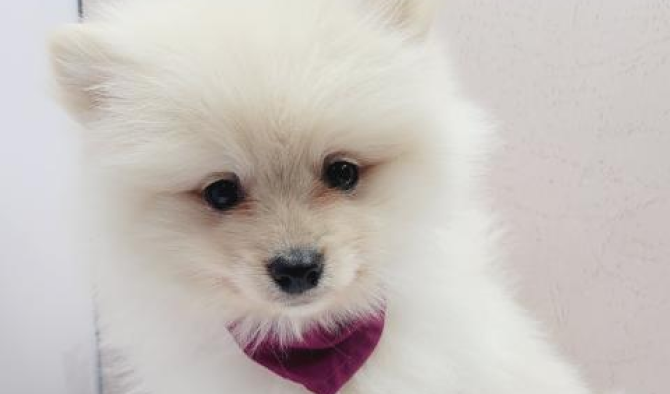

- Phone
- Email puppypetite@aol.com
-
Address
8002 17th Ave, Brooklyn NY 11214

How To Crate Train A Pomeranian Puppy
Pomeranian puppies, often referred to as 'Poms', are a captivating breed, known for their small size, majestic fur, and energetic disposition. Their striking appearance and endearing characteristics have earned them recognition and admiration worldwide.
Poms stand out with their fox-like face and dense double coat, typically in shades ranging from red, orange, cream, to black and sable. Their luxurious fur is one of their distinct features, making them appear larger than their actual size which typically ranges from 3 to 7 pounds.
In terms of attitude, Pomeranian puppies are known for their vivacious and spirited nature. Despite their small size, they possess a large-dog attitude. They are intelligent, alert, and curious about their surroundings. This makes them excellent companions but it also means they can be somewhat assertive and require consistent training from a young age.
Beyond their appearance and attitude, Pomeranians are also known for their loyalty and affection towards their human families. They crave attention, and their sociable nature makes them great family pets. However, their small size and delicate structure mean they're best suited to families with older children who can handle them gently.
Pomeranian puppies, with their unique combination of physical charm and spirited attitude, make a delightful addition to many homes. Their loyalty and vivacious disposition require dedicated care and attention, ensuring a rewarding companionship for those who choose to bring these energetic little creatures into their lives.


What is Crate Training?
Crate training is a method of house training dogs that involves the use of a crate or cage. The goal is to create a safe, comfortable space that the dog sees as its den, where it can retreat for comfort and solitude while also serving as a highly effective tool for teaching bladder and bowel control.
The process begins by choosing the right-sized crate, providing only enough space for the dog to stand, turn around, and lie down comfortably. Too large a crate might give the dog space to relieve itself in one corner and sleep in another. Once the appropriate crate is selected, the dog is introduced to it gradually. Meals, treats, and toys can be placed inside to encourage the dog to enter voluntarily.
The next step is to begin creating a positive association with the crate through short, supervised periods of confinement. Start with short intervals and gradually increase the duration. Over time, the dog will start to understand the crate as its personal space and feel comfortable staying there voluntarily.
Overnight crating is often the final stage in crate training, teaching dogs to hold their bladder and bowel movements for longer periods. It's important to ensure that the dog has had sufficient exercise and an opportunity to relieve itself before being crated overnight.
Crate training is an effective method for teaching dogs household etiquette and providing them with a safe, comfortable space. It requires patience and consistency, but the payoff is a well-adjusted pet who is comfortable with periods of solitude and has mastered house training. It's important to remember that the crate should never be used as a form of punishment, and the dog should not be left in the crate for long periods of time, as this can lead to anxiety and other behavioral problems.
How to Crate Train a Pomeranian Puppy
Crate training a Pomeranian puppy can be a beneficial method to ensure the dog has a safe, comfortable space of its own, and it can also assist in house training. This process can be outlined in a series of steps, each playing a crucial role in creating a positive crate environment for your puppy.
Step 1: Select the Appropriate Crate Size:
The first step in crate training your Pomeranian is to choose a crate that is the right size. It should be big enough for the puppy to stand, turn around, and lie down comfortably, but not so large that there's room for the dog to relieve itself in one corner and sleep in another.
Step 2: Introduce the Puppy to the Crate:
Start by placing the crate in a common area where the family spends a lot of time. Add a soft blanket and some toys, and let the puppy explore the crate at its own pace. Reward your puppy for entering the crate, to start building positive associations.
Step 3: Feed Meals in the Crate:
Start feeding your puppy its meals inside the crate. This will create more positive associations and make the puppy more comfortable in the crate.
Step 4: Begin Short, Supervised Periods of Confinement:
Once your puppy is comfortable eating in the crate, you can start confining them in the crate for short periods of time while you're home. Start with short intervals, gradually increasing the amount of time your puppy spends in the crate.
Step 5: Gradual Increase of Crate Time:
Over time, slowly increase the length of these confinement periods. Always ensure your puppy has relieved itself before being crated to avoid accidents.
Step 6: Overnight Crating:
After the puppy is comfortable being crated for longer periods, you can start crating them overnight. Make sure the puppy has had plenty of exercise and a chance to relieve itself before being crated for the night.
Crate training is a valuable tool for both house training your Pomeranian puppy and providing it with a safe, comfortable space where it can relax. It requires patience and consistency but can result in a well-adjusted dog that is comfortable with periods of solitude. Remember, the crate should never be used as a form of punishment and the puppy should never be left in the crate for extended periods as this can lead to anxiety and other behavioral problems.
Crate Training for Travel
Crate training is not only useful for house training but also crucial for safe and stress-free travel with your Pomeranian puppy. Ensuring your puppy is comfortable in a crate can significantly improve their travel experience, making journeys more enjoyable for both of you. Here are some steps to prepare your pup for their travel adventures.
Introduce the Travel Crate
Start by introducing a travel-sized crate to your puppy. This crate should be sturdy, secure, and well-ventilated. It should also be large enough for your puppy to stand, turn around, and lie down comfortably, but not so large that it doesn't feel like a secure den.
Create Positive Associations
Like with the home crate, create positive associations with the travel crate. Use treats, toys, and meal times to make the crate a happy place.
Practice Short Journeys
Begin by taking short trips with your puppy in the crate. These can be as simple as a drive around the block. Gradually increase the duration of these trips over time.
Regular Breaks
During longer journeys, ensure to take regular breaks so your puppy can stretch, play, and relieve itself. Always make sure your puppy is securely leashed before opening the crate in an unfamiliar location.
Overnight Stays
Once your puppy is comfortable with longer journeys, try an overnight stay with the travel crate. This could be at a pet-friendly hotel or a family/friend's house. This will help your puppy get used to being in the crate in different environments.
Crate training for travel is a process that requires patience and consistency, much like regular crate training. It's important to gradually build up your puppy's comfort levels and always associate the crate with positive experiences. No journey should ever feel forced, and your puppy should always feel safe and secure in their travel crate. Remember, every dog is different and some might take longer to adjust than others. In the end, the reward is well worth the effort: a travel-ready pup, eager for the fun adventures travel brings.
